There are over 50 different breeds of blue chickens spread across the world. However, less than 40 of them are included in the American Poultry Association and other associations for poultry standards.
Blue chicken breed numbers grow daily since many variants are bred frequently, giving rise to new versions. Many variations exist, some having solid blue colors, others with just blue shades, and the rest with blue patterns.
Only a few are well-recognized or approved breeds. New chickens must meet a certain criterion to be included in poultry standards like the APA. This article dives into the genetics behind the admitted blue chickens, their different variations, and the popular breeds of blue chickens that exist today,
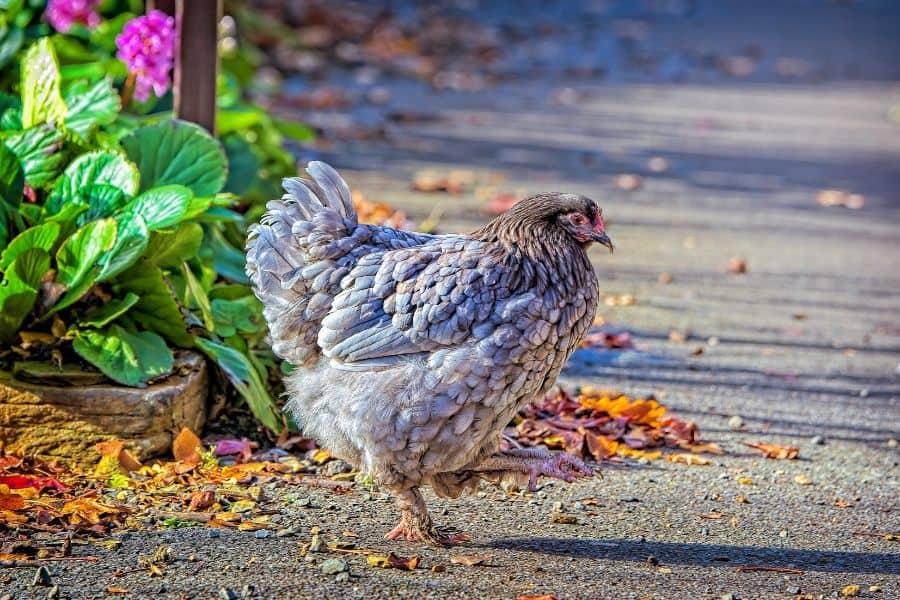
Some of these unique blue chickens include the Sapphire Gem (also known as the Sapphire Rocks, Sapphire Blue, or Blue Rocks), the famous Blue Cochin with a grayish blue plumage, and the Blue Silkie Bantams with a brighter pastel blue.
Read on to learn everything about blue chickens and get answers to some of your frequently asked questions.
What Breed Of Chicken Is Blue? How Is Blue Chicken Made
Not all chickens that look blue are called blue chickens. There is a difference between chickens that look blue and those that actually have the blue gene in their DNA.
Do not worry; this won’t be a lecture on genetics. As backyard chicken keepers, an overview understanding is all that is needed to help produce specific varieties for show or sale.
To start, let’s understand how breeds of chicken become blue:
1. Self-Blue Chickens
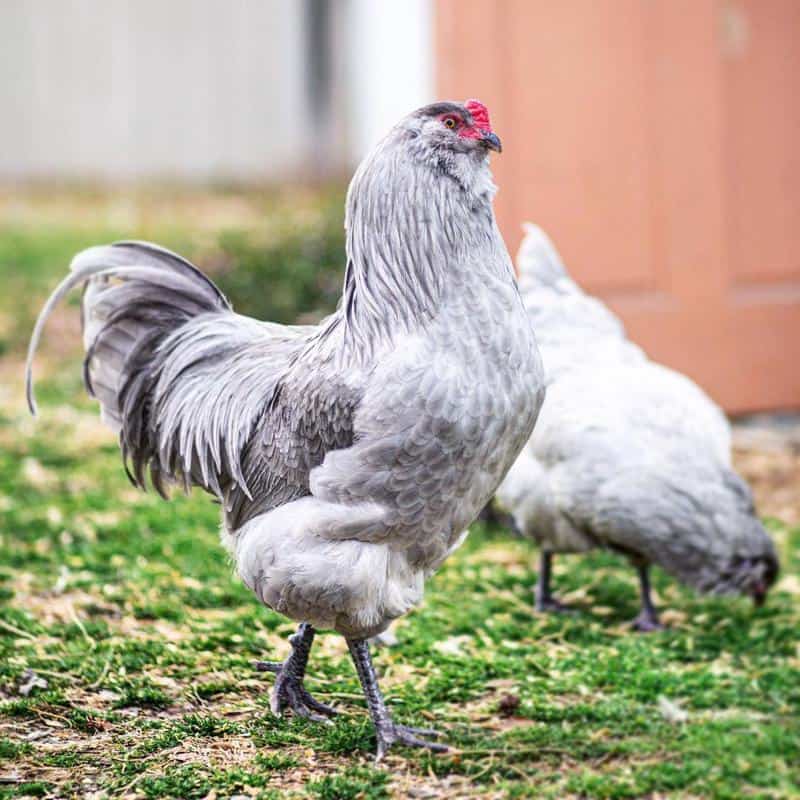
Self-Blue plumage color in chickens means that the blue is solid, evenly spread throughout the body, and doesn’t include other colors or any patterns.
However, it is important to note that the self-blue color isn’t considered blue; it just looks blue. The color is a lot lighter and is comparable to lavender.
Therefore, whenever you see breeders refer to self-blue, know they are talking about lavender chickens instead of true-blue-colored chickens.
Self-Blue chickens naturally breed to give rise to 100% lavender chicks since they lack the black (BB) and splash (bb) gene variations that give rise to blue chickens.
2. Through Genotypes
This is how we get true blue-colored chickens.
In color genetics, you cannot make a blue chicken by mixing black genes (BB) with white ones (WW). BB and WW are dominant genes forming BW (black and white) chickens when combined.
Instead, a blue chicken is formed when you add a blue dilution gene (bb) to a black chicken (BB). The result is a blue chicken with a blue (Bb) color genetic code.
The (bb) blue dilution gene (also known as the splash gene) is dominant in splash-colored chickens – white/grey chickens with random dark grey/blue/black splotches.
Essentially, you can 100% get blue chickens by breeding a black (BB) and a splash (bb) parent.
Also called the diluting gene, the splash (bb) can be expressed with one gene (b) or both (bb). One copy (b) is expressed to allow dilution, but if two copies (bb) are expressed, then the dilution is higher.
With that in mind, blue dilution (bb) dilutes black (BB) to form a wide variety, including blue (Bb), black (BB), and splash (bb) colored chickens.
For example, in a breeding pen for blue, black, and splash coloration, the results will be something like this:
- Black (BB) x Black (BB)= 100% black (BB) chickens.
- Black (BB) x Splash (bb)= 100% blue (Bb) chickens.
- Black (BB) x Blue (Bb) = approximately 50% blue chickens (Bb) and 50% black chickens (BB)
- Blue (Bb) x Blue (Bb) = approximately 25% black (BB)chicks, 50% blue (Bb), and 25% splash (bb) chicks
- Blue (Bb) x Splash (bb) = approximately 50% blue (Bb) chicks and 50% splash (bb) chicks.
- Splash (bb) x Splash (bb) = 100% splash (bb) chickens.
Please keep in mind that the shades of blue are not the same across the different breeds. Blue dilution allows for high or low expression, giving rise to many shades of blue. Some are lighter in color, and others are darker in color.
The American Poultry Association (APA) standard of perfection, one of the leading associations for classifying chicken breeds, requires bluebirds to have laced blue plumage in order to be included in their standard.
We will also look at other standards like the American Bantam Association (ABA), British Poultry Standard (the Poultry Club), and Australian Poultry Standard.
Please remember that not all blue chickens are listed on these lists. However, if a blue chicken breed is not listed on these lists, then they are not eligible for livestock shows where they can be ranked competitively.
With that in mind, we will only look at the ones on the approved lists.
38 Blue Chicken Breeds: The Complete Approved List
| Blue Chicken Breed | Average Weight (lbs.) | Egg Weight | Egg Color | Egg production per year |
| 1. Blue Ameraucana | 5.5 – 6.5 | Medium – Large | Blue | High |
| 2. Blue Andalusian | 7.0 – 8.0 | Large | White | High |
| 3. Blue Australorp | 3.2 – 4.2 | Medium – Large | Brown | High |
| 4. Blue Cochin | 5.0 – 6.0 | Medium | Brown | Low-medium |
| 5. Blue Jersey Giant | 13+ | Large | Brown | High |
| 6. Blue Langshan | 9+ | Large | Brown-Yellow | Fair |
| 7. Blue Orpington | 3.5 – 4.7 | Large | Brown | Fair |
| 8. Blue Plymouth Rock | 8+ | Large | Brown | Medium-High |
| 9. Blue Sumatra | 3.5 – 5.5 | Small | White | Fair |
| 10. Blue Wyandotte | 6.5 – 8.5 | Medium | Brown | High |
| 11. Blue Ameraucana Bantam | 1.2 – 2.0 | Small | Blue | Fair |
| 12. Blue American Game Bantam | 3 – 5 | Small | White – Ivory | Low-Medium |
| 13. Blue Andalusian Bantam | White | Fair | ||
| 14. Blue Araucana Bantam | 1.7+ | Small | Blue | Fair |
| 15. Blue Belgian Bearded d’Anver Bantam | 1.2 – 1.6 | Small | Creamy White | Fair |
| 16. Blue Belgian Bearded d’Uccle Bantam | 1.7+ | Small | Cream, tinted | Fair |
| 17. Blue Booted Bantam | 1.9 + | Small | White, Tinted | Low |
| 18. Blue Cochin Bantam | 1.2 – 1.5 | Small | Brown | Fair |
| 19. Blue Cornish Bantam | 1.6 – 2.5 | Small | Light Brown | Fair |
| 20. Blue Dutch Bantam | 1.2 + | Small | Light brown | Fair |
| 21. Blue Faverolle Bantam | 2.0 – 2.2 | Small | Tinted brown | Fair |
| 22. Blue Japanese Bantam | 2.0 – 2.2 | Small | Cream | Fair |
| 23. Blue Langshan Bantam | 1.6 – 2.2 | Small | Dark Brown | Fair |
| 24. Blue Leghorn Bantam | 1.3 – 1.8 | Small | White | Fair |
| 25. Blue Modern Game Bantam | 2.3 – 2.8 | Small | White | Fair |
| 26. Blue Naked Neck Bantam | 1.6 – 2.2 | Small | Light brown | Fair |
| 27. Blue Old English Game Bantam | 2.5 – 2.5 | Small | Cream, tinted | Fair |
| 28. Blue Orpington Bantam | 2.3 + | Small | Brown | Fair |
| 29. Blue Plymouth Rock Bantam | 2.0 – 2.5 | Small | Brown | Fair |
| 30. Blue Polish Bantam | 1.8+ | Small | White | Fair |
| 31. Blue Rosecomb Bantam | 1.3 – 1.6 | Small | Tinted brown | Fair |
| 32. Blue Silkie Bantam | 2.0 – 2.5 | Small | Brown | Fair |
| 33. Blue Spanish Sultan Bantam | 1.3 – 1.6 | Small | White | Fair |
| 34. Blue Sumatra Bantam | 2.0 – 2.4 | Small | White | Fair |
| 35. Blue Watermaal Bantam | 2.0 – 2.5 | Small | Brown | Fair |
| 36. Blue Wyandotte Bantam | 4 – 5 | Small | Brown | Fair |
| 37. Blue Rock (Production blue chicken) | 4.5 – 5.5 | Large – Extra Large | Light Brown | High |
| 38. Blue Copper Maran | 2.0 – 2.5 | Large | Dark Brown | Medium- High |
Top 11 Attractive Blue-Feathered Chickens
It is crucial to note that even though some of these chickens are popular, few hatcheries and breeders may have most of them in stock or for show. They are hard to breed, and getting a flock to give out specific chicks can take a long time.
Feel free to check with your local poultry associations and breeders for any availability. You can start by online checking popular hatcheries like Murray McMurray Hatchery, Meyer, Hoover’s Hatchery, and Cackle Hatchery.
1. Blue Ameraucana Chicken
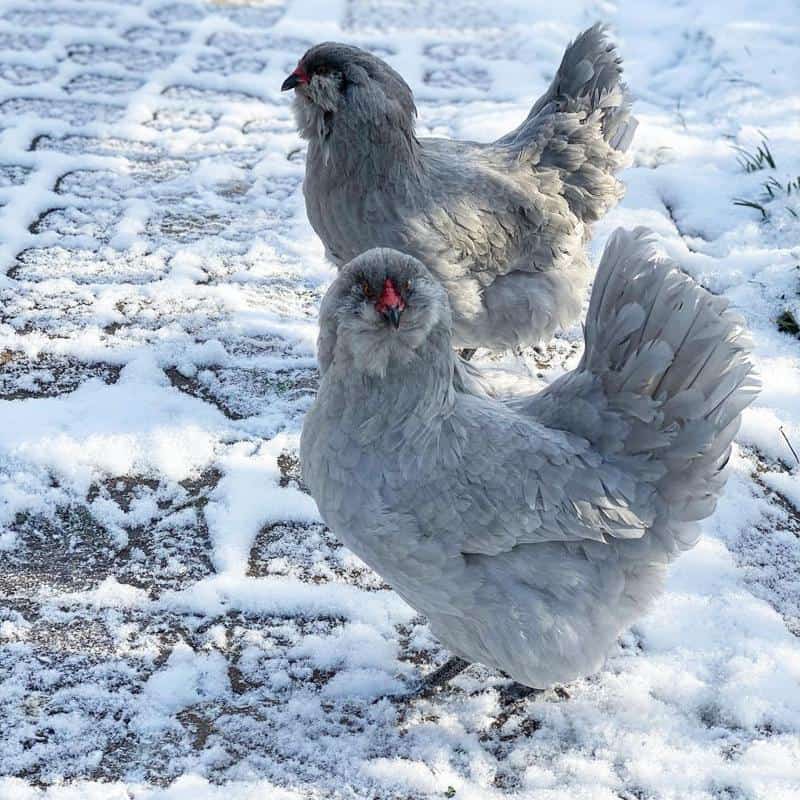
The Ameraucana is a common chicken that is primarily kept for its high egg production (over 250/year). It comes in a variety of colors, including blue, black, white, and silver.
It is an American breed developed in the 1970s from a breed of Araucana chickens from Chile, mainly to retain the blue-egg genes from parents.
One of the contributing factors to the Ameraucana chicken breed’s popularity is its ability to lay blue eggs. In fact, if you look for blue egg layers in hatcheries, there is a good chance most will be Ameraucanas.
The striking blue plumage of the Blue Ameraucana variant is an enticing factor to its fame, and the beautiful slate-blue shanks plus pea combs make them cute, lovable pets to keep.
Blue Ameraucanas also boasts distinctive beard and muffs, adding to their unique appearance.
They are also great for breeding other blue chickens, including the Arctic blue chicken breed, a cross of Araucanas and Ameraucanas that lays blue and green eggs.
2. Blue American Game Bantam– Delaware Blue Hen
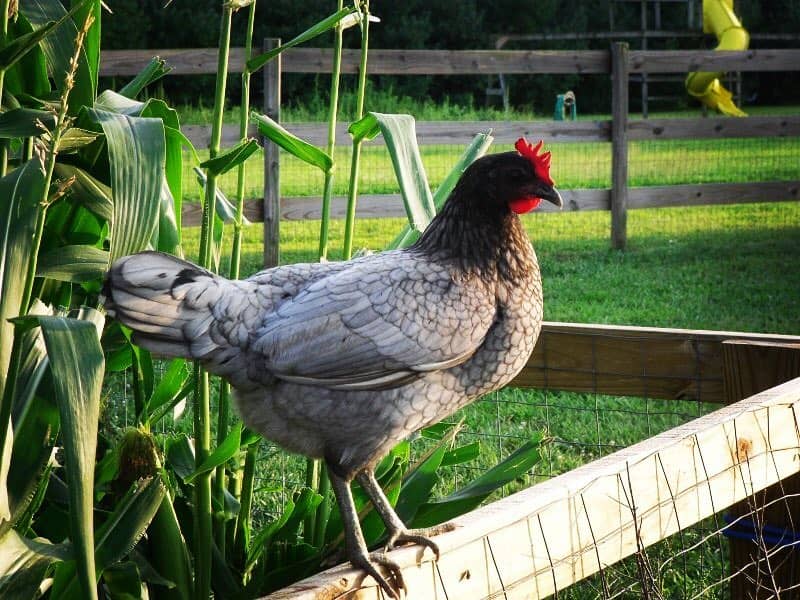
The Blue American Game Bantam is less recognized than the black variant since black is the breed’s primary color.
American Gamecock is a physically large, hardy, and vigorous breed primarily kept for cockfighting and exhibition. It is also kept as an ornamental due to its low-medium egg production.
Delaware blue hen is a strain of the American gamecock that isn’t as fierce and revered in the gamecock sports. The lighter shade of blue and its hardiness are why the chicken was selected as the mascot of several institutions in Delaware, including the University of Delaware, under the name Blue Hen Chicken.
It is important to note that the Delaware Blue Hen is not an approved chicken breed in the APA.
3. Blue Andalusian
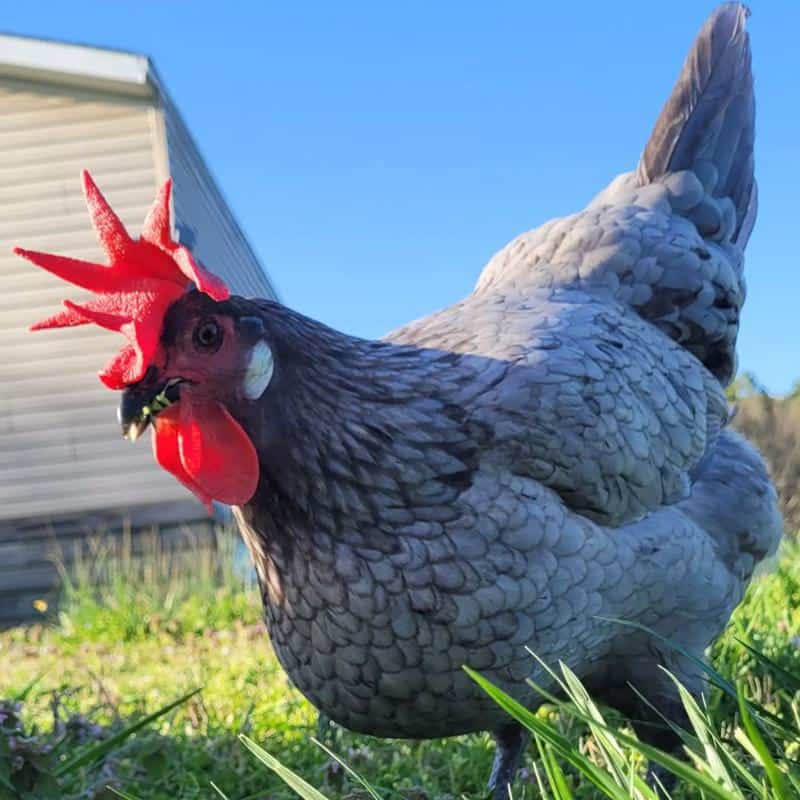
Blue Andalusians are an excellent choice if you desire a prolific egg layer. These birds produce many white eggs and are known for their ability to thrive in free-ranging environments.
Recognized by the APA in 1874, the Andalusian breed only comes in a distinctive blue.
It is also a good breed for creating other beautiful variants, including the blue Star Chicken formed from a crossbreed between a blue Andalusian and Barred Rock.
4. Blue Australorp
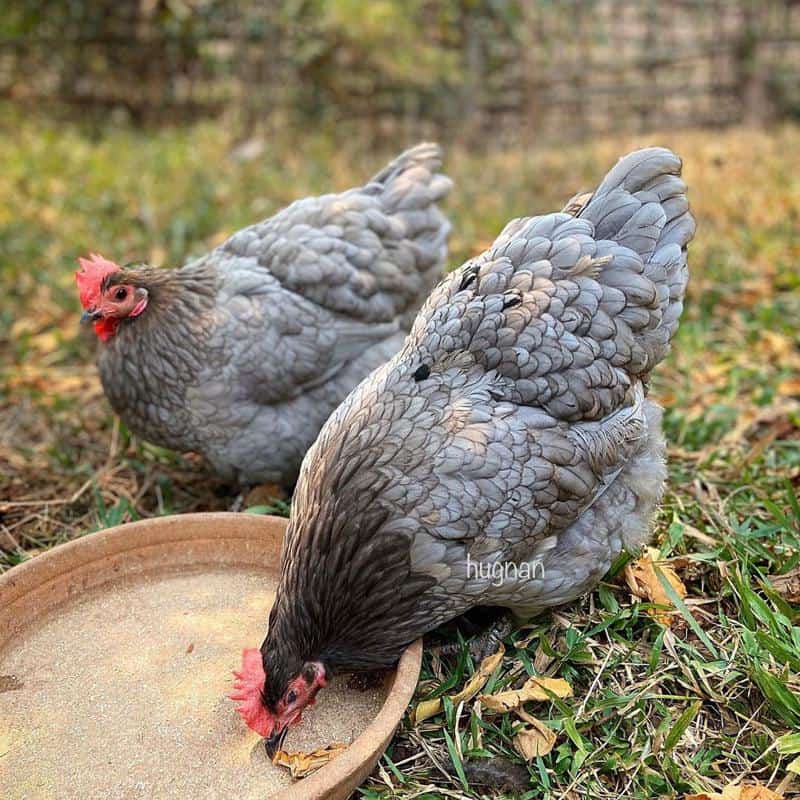
As the name suggests, the Blue Australorps are native to Australia, reaching the American shores in the 1920s. The colors are several, including white and black.
The Blue Australorp has a rich blue hue with s glossy sheen. They are large egg layers also kept for their meat production capabilities. These docile and hardy creatures are mainly kept for eggs, with upwards of 300 eggs per year.
5. Blue Cochins
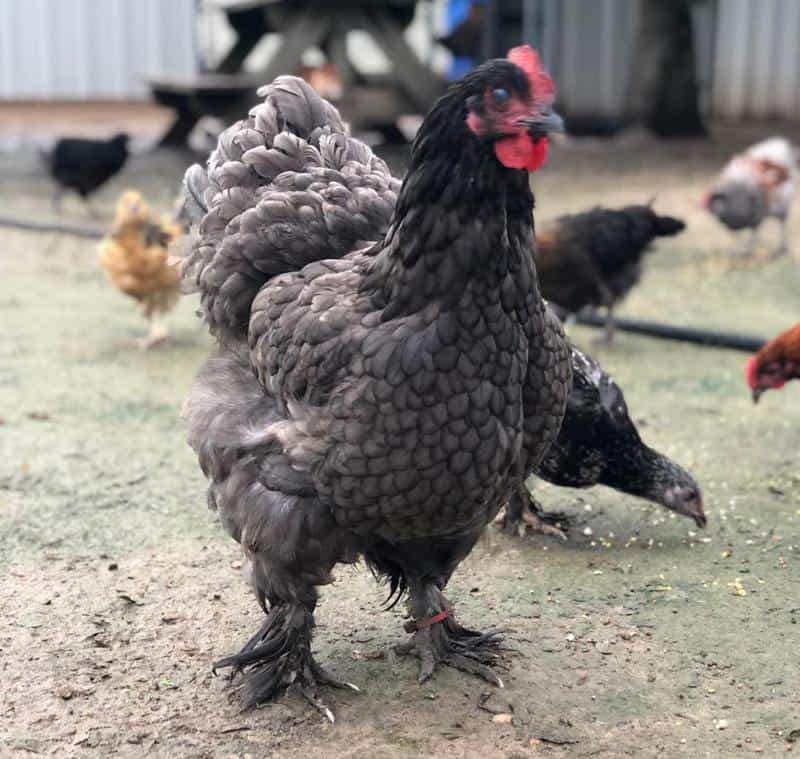
The upside of blue cochins is they are fowls and bantams alike. They also include frizzle chickens, making Blue Cochins one of the most diverse blue chickens.
Originating from China, the APA recognizes these bluebirds as an Asiatic breed, sometimes called the Asian Blue Chicken breed.
Blue Cochins are attractive but rare, including bantams like the lemon blue cochin bantam. They have feathered legs, and their plumage is bluish-slate with bright red combs that are gorgeous to look at.
6. Blue Marans
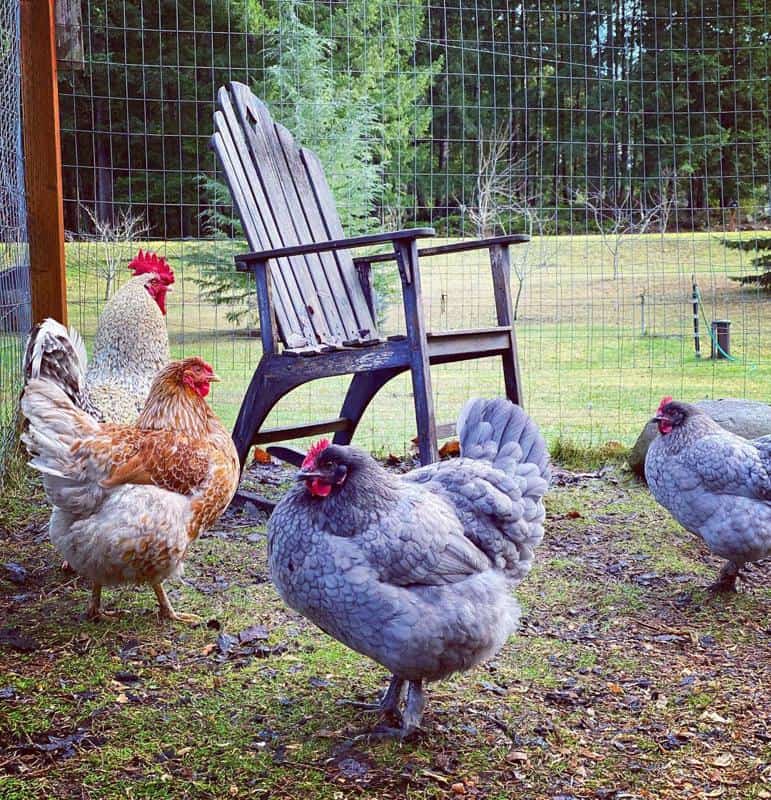
Blue Marans come in different variants, including the upcoming popular Blue Copper Maran, also known as the French Maran – a 2016 addition to the Australian Poultry Standard.
The Black Copper Marans breed is known for its dark chocolate brown eggs. While they may be slightly harder to find, their attractive appearance makes them valuable to any flock.
7. Blue Rocks
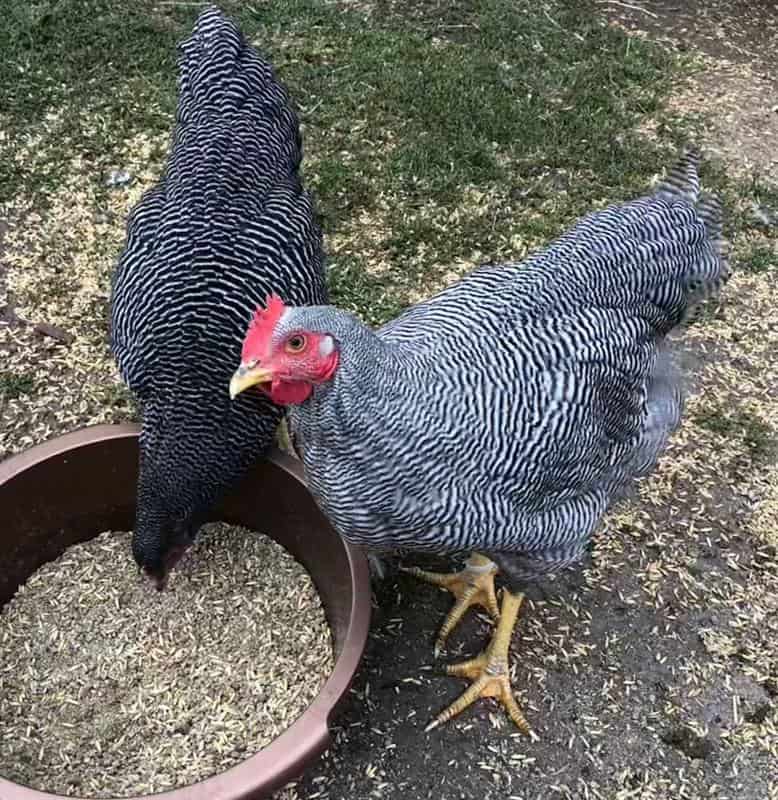
Blue Rocks is a popular production of blue chicken that is known by many names across the world, including sapphire gems, sapphire rocks, blue Plymouth chickens, blue Plymouth rock chicken, blue Plymouth tint chicken, and blue sapphire chicken.
Its high egg production level is a contributing factor to its popularity. In fact, these production blue chickens can lay about 300 eggs per year.
Another similar blue breed that can compete with Blue Rocks in terms of production is the Whiting True-Blue Chicken. It is a recent blue chicken (unrecognized by APA) developed by Dr. Tom Whiting. They can lay upwards of 300 blue eggs/year for 3 years straight.
Despite its popularity and mesmerizing cute dark blue coloration, Blue Rocks are not recognized by the APA. This may be due to the fact they are a 1st-gen cross breed of native Blue Andalusian with a Plymouth Rock.
Blue Rocks/Sapphire gems have also been known to give rise to a few interesting offspring like the blue Sapphire Olive Egger – a hybrid from crosses of multiple chickens, including Sapphire gems and the Ameraucana or Arausana. Sapphire Olive Egger is popular for its olive-green-colored eggs.
8. Blue Silky Bantam
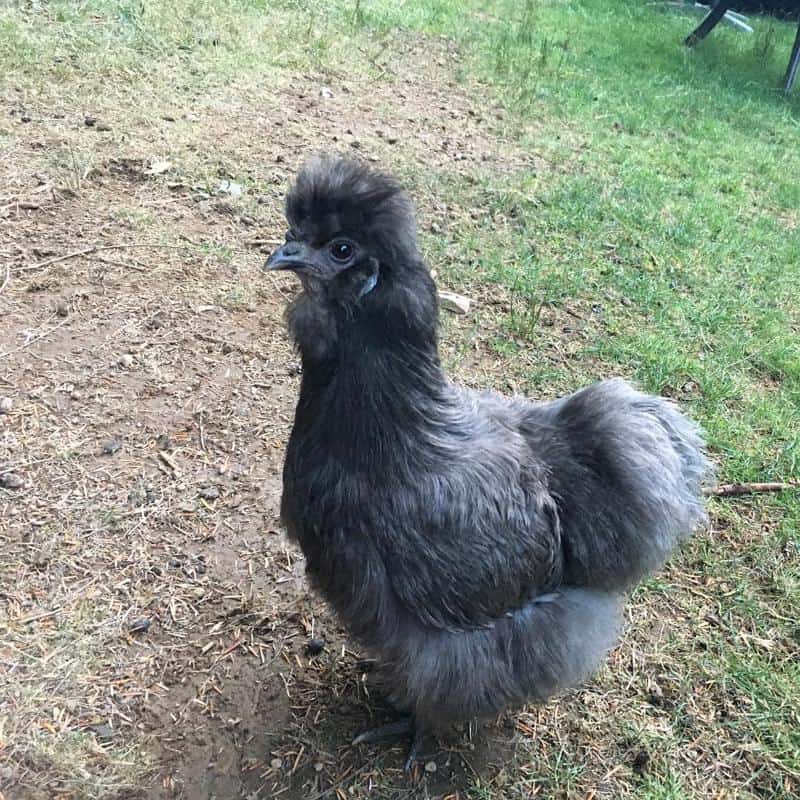
The bright pastel blue-colored Blue Silkie Bantam is also known as the bearded self-blue silkie bantam. The walnut comb chicken originates in Marco Polo but is bred worldwide for its unusually attractive thick black-blue feathers that feel like hair.
You can get them as bearded or non-bearded, but we recommend you opt for the former due to its cute looks and fluffy-looking feathers.
Another attractive aspect of the blue silkie chickens is their constant recurrence of black, white, and blue variants. If breeding is your goal, go for the finest blue silkies since they produce the best variants.
9. Blue Sumatra
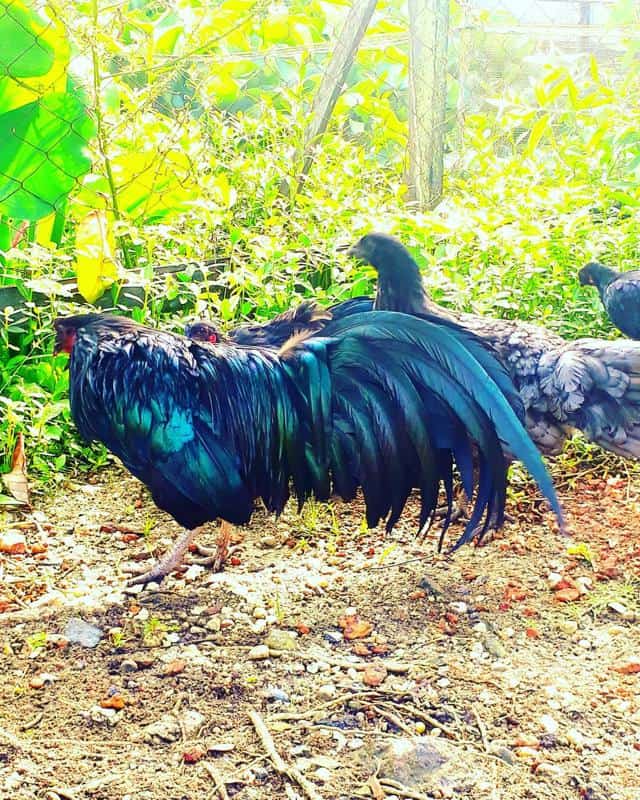
Blue Sumatra are some of the readily available blue chickens on the market for as low as $5.15. recognized by the APA since 2002, the Blue Sumatra roosters stand at the height of 4+ feet with a fertility rate of up to 55%.
They are kept for both ornamental and egg-laying purposes, but their looks and fair production make them ideal for shows and exhibitions. The primary glossy blue plumage with white wing tips, abdomen, and chest is complemented by the pea comb, black legs, long tails, and sickles.
10. Blue Wyandotte
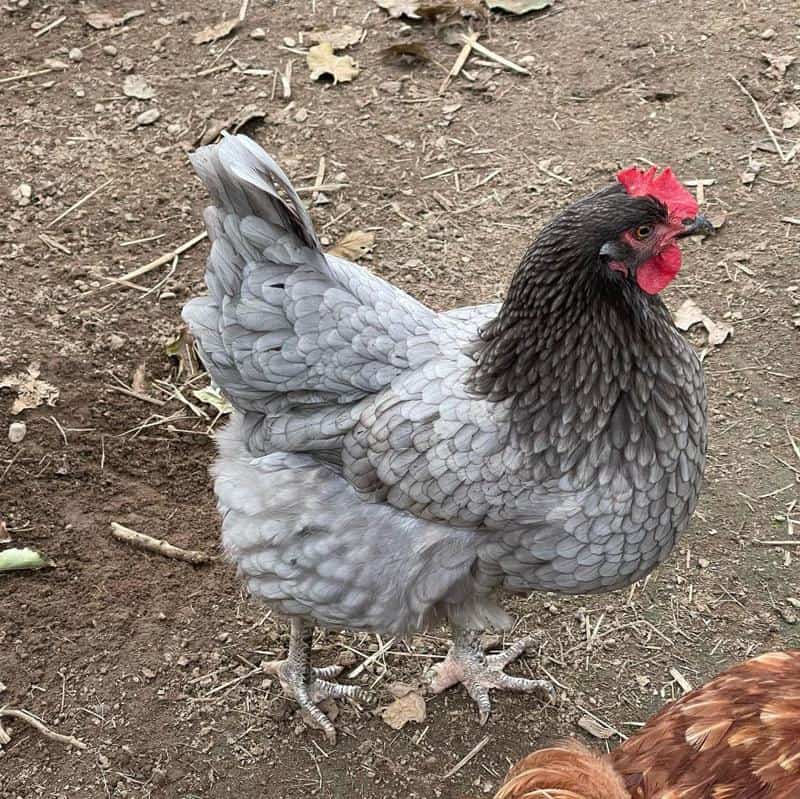
Blue Wyandottes are available in uniform solid blue variations, offering an all-blue option for enthusiasts. However, the Blue Laced Red Wyandotte is the most popular, with a blue base laced with reddish to golden shades. Other color variants are available, including white and brown.
The breed is not only popular for its color but egg-laying production (180 – 260 eggs per year). It is ranked by many as the best breed for brown egg-laying.
11. Rhode Island Blue
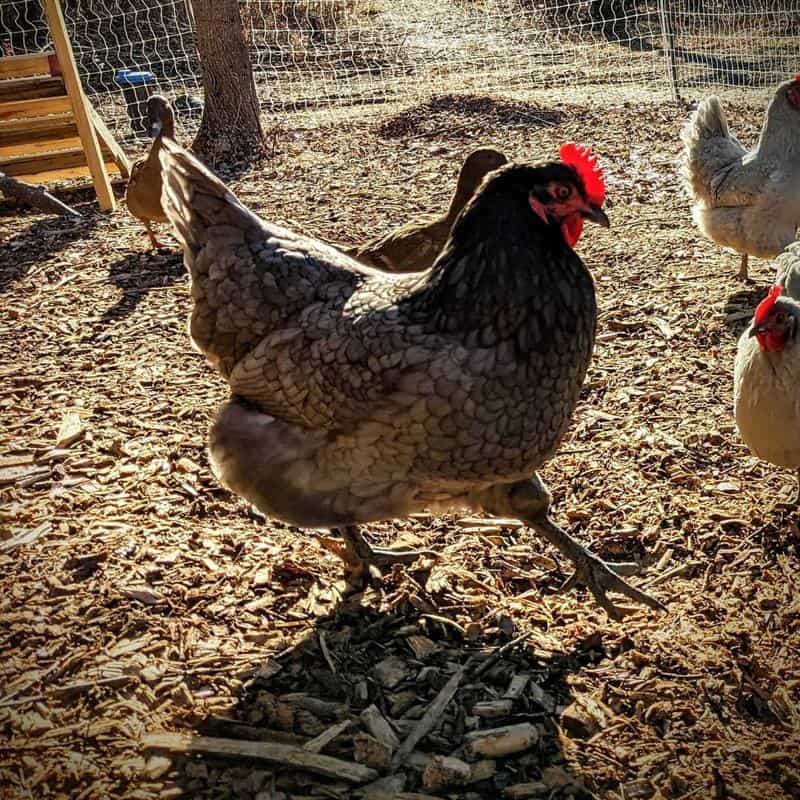
The Rhode Island Blues are a relatively new hybrid that aren’t recognized under the APA. They are a cross between Rhode Island Reds and the Australorp.
There are different colorations depending on the cross breeds. Common ones are the standard blue Rhode Island Blues but other varieties come with a blue-red mixture (a result of combining blue, red, and black chickens).
With over 260 eggs per year, the Rhode Island Blues are productive layers of large brown eggs. The multi-colored bird is also friendly and would make a great pet for young kids or bird enthusiasts. However, keep in mind that the roosters can be more aggressive at times.
Also Read:
Blue Chicken: FAQs
What Breed of Chicken Lays Blue Eggs?
It is important to note that not all blue chickens lay blue eggs. In fact, most of them do not. The only blue egg-laying chickens recognized by the American Poultry Association include the Araucanas and Americans.
Some unrecognized cross breeds of these chickens, including the Whiting Blue Chicken (Leghorn and Ameraucana), also lay blue eggs.
What Is a Blue-Legged Beauty Chicken?
Different breeds and crosses can have blue-legged beauty chickens. A recent addition is the Tractor Supply blue-legged chicken, said to be a breed between an Americauna and Blue Lace Wyandotte. Others are Andalusian variants or Red Pyle Old English.
How Much Does a Blue Chicken Cost?
Blue chicken prices vary with breed, coloration, availability, popularity, and usage. On average, you can find a blue chicken for as low as $13 or as high as $50 for 1-4 chicks.
For example, Blue Andalusian at $5 for one, Blue Ameraucana costs $13 for 1-3 chicks, Blue Sumatra is $5 for 1-3 chicks, and Blue Silkie chicken is $30 for 1-4 chicks.
Conclusion
Blue feathered chickens are an enchanting addition to any flock, providing a burst of color and visual appeal. With an extensive range of chicken breeds exhibiting blue plumage, you have numerous options to choose from when selecting your blue-feathered companions.
Whether you prefer large fowl or bantam breeds, there is a blue chicken breed to suit your preferences. Remember to check with your country’s poultry association for a comprehensive list of recognized blue chicken breeds.
